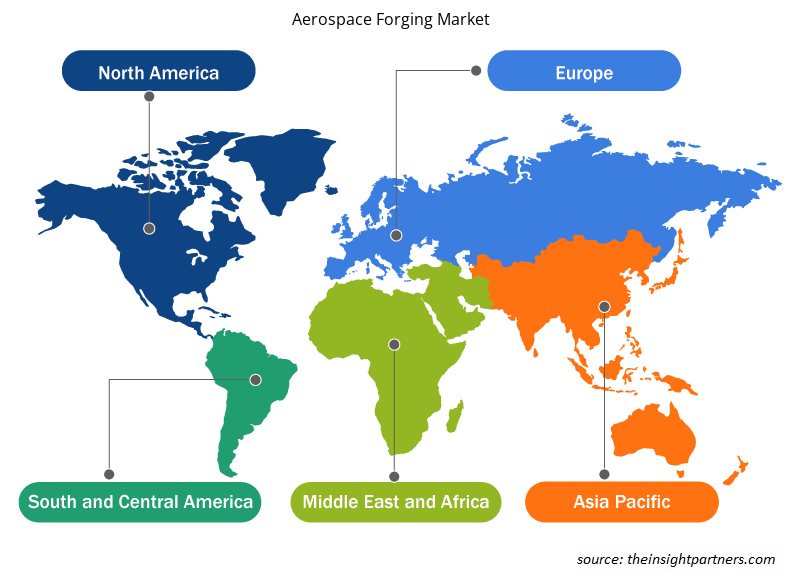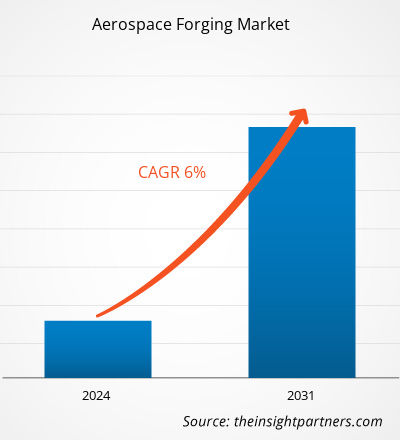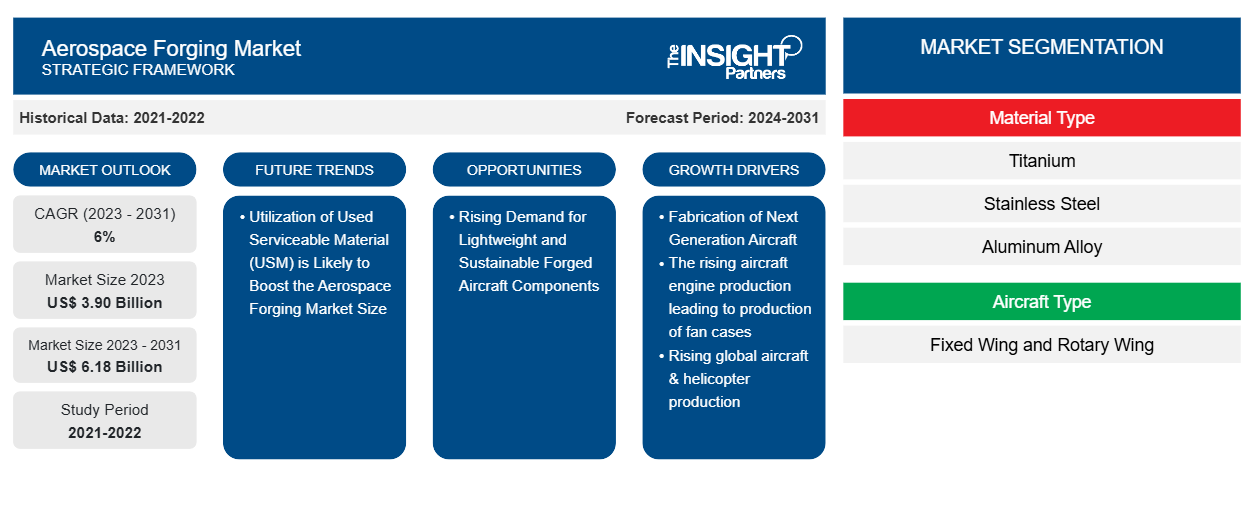Se proyecta que el tamaño del mercado de forja aeroespacial alcance los 6.180 millones de dólares estadounidenses para 2031, desde los 3.900 millones de dólares estadounidenses en 2023. Se espera que el mercado registre una CAGR del 6,0 % entre 2023 y 2031.
América del Norte alberga más del 40% de la flota mundial de helicópteros y, por lo tanto, planea comprar y reemplazar la flota existente por una nueva en los próximos años. De esta manera, la región es competente para satisfacer las necesidades del mercado aeroespacial. Reemplazar las flotas existentes por helicópteros nuevos también impulsará simultáneamente el mercado de la forja aeroespacial. Algunas de las empresas involucradas en el negocio de fabricación y suministro de motores de aeronaves y productos de forja incluyen The Boeing Company, Patriot Forge Co., Scot Forge, United Technologies Corporation y otras.
Análisis del mercado de forja aeroespacial
Es probable que el mercado de forjado aeroespacial experimente un fuerte crecimiento durante 2023-2031. Esta demanda de filtros aeroespaciales está impulsada principalmente por la demanda de aleaciones de aluminio y titanio para la producción de diferentes componentes de aeronaves, como carcasas de ventiladores, discos de turbinas y rotores. Además, el aumento en la producción de motores de aeronaves es otro factor importante que genera una nueva demanda de forjados aeroespaciales en todo el mundo.
Descripción general del mercado de forja aeroespacial
Es probable que el mercado de forja aeroespacial muestre un crecimiento vigoroso durante 2023-2031. La demanda del mercado de forja aeroespacial está impulsada principalmente por algunos de los factores mencionados a continuación:
- El aumento de la producción de motores de aviación conduce a la producción de carcasas de ventiladores.
- Aumento de la producción mundial de aviones y helicópteros
- Demanda de MRO de la flota de aeronaves existente
- Aumento de la producción de aviones militares
Es probable que estos factores expresen un crecimiento saludable del mercado de forja aeroespacial. Además, Estados Unidos representó la mayor parte del mercado mundial de forja aeroespacial en 2023. El país es un fabricante líder de equipos de aviación general, como aviones pequeños, helicópteros y aviones comerciales. La industria aeroespacial del país ha observado un cambio en la inversión manufacturera. El país representa actualmente más del 35% de la producción aeronáutica mundial. Además, la presencia de algunos de los principales fabricantes de equipos originales de aeronaves, a saber, Boeing, Airbus, Bombardier y Textron Inc., tienen sus bases de fabricación establecidas en los EE. UU. Estos actores de renombre también respaldan el negocio de la forja aeroespacial a medida que aumenta la necesidad de productos forjados aeroespaciales con un repunte en la producción de aeronaves. Precision Metal Product Inc., Scot Forge, Fountaintown Forge, Pacific Forge Incorporated, Arconic Inc. y Mettis Aerospace Inc. son algunos de los actores importantes que operan en el mercado de forja aeroespacial de EE. UU.
Personalice este informe según sus necesidades
Obtendrá personalización en cualquier informe, sin cargo, incluidas partes de este informe o análisis a nivel de país, paquete de datos de Excel, así como también grandes ofertas y descuentos para empresas emergentes y universidades.
-
Obtenga las principales tendencias clave del mercado de este informe.Esta muestra GRATUITA incluirá análisis de datos, desde tendencias del mercado hasta estimaciones y pronósticos.
Factores impulsores y oportunidades del mercado de la forja aeroespacial
Fabricación de aeronaves de próxima generación
Dentro de la industria aeroespacial comercial, se prevé que la producción de aviones de pasillo único, aviones de pasillo doble de gran tamaño y motores a reacción de próxima generación sea un factor de auge. El motor a reacción de próxima generación utiliza aleaciones avanzadas de polvo metálico y superaleaciones a base de níquel. Es un modelo económico de la aeronave, que ayuda a mejorar la eficiencia del combustible y el rendimiento de una aeronave. Por ejemplo, Airbus y Boeing han recibido un pedido para la fabricación de más de 40.000 aeronaves. La producción de aeronaves masivas de próxima generación aumentará con el tiempo el mercado de componentes aeroespaciales. Además, se prevé que la producción de aeronaves de próxima generación también proporcione amplias perspectivas de crecimiento a las empresas de forjado de componentes aeroespaciales.
Es probable que la utilización de material útil usado (USM) impulse el tamaño del mercado de forjado aeroespacial
Con el aumento continuo de los viajes aéreos, el número de aviones aumenta considerablemente para satisfacer la creciente demanda de los consumidores. Sin embargo, en la situación actual, entre 400 y 600 aviones comerciales se retiran, envejecen y se desmontan cada año, lo que genera una gran cantidad de residuos. Esta enorme cantidad de residuos incluye aproximadamente 1000 toneladas de fibra de carbono, 1800 toneladas de aleaciones, 30 000 toneladas de aluminio y 600 toneladas de otros materiales de desecho. En el contexto de la creciente preocupación por el medio ambiente, las empresas aeroespaciales como Pratt & Whitney, junto con los organismos gubernamentales, han identificado nuevas formas de reemplazar las materias primas con materiales reciclados y renovables para la fabricación de piezas aeroespaciales.
Según la Organización de Aviación Civil Internacional (OACI), se espera que la vida útil de casi 18.000 aviones termine en los próximos 10 a 15 años debido al aumento del tráfico aéreo. Por lo tanto, se espera que el uso de materiales reciclados brinde enormes oportunidades para las empresas de forja aeroespacial. Por ejemplo, Boeing y Bharat Forge Ltd. han mostrado su interés en ingresar al mercado de USM. Además, en América y Europa, el negocio del reciclaje brinda enormes oportunidades tanto a los fabricantes de aeronaves como a las empresas de forja aeroespacial. Por el contrario, cada país tiene sus términos y condiciones relacionados con las industrias y sus actividades. Por ejemplo, anteriormente, Europa se enfrentó a dificultades a la hora de comprar o reciclar titanio. Por lo tanto, para erradicar esta situación, EcoTitanium es la primera unidad que recicla aleaciones de titanio de grado aeronáutico. Esta instalación utilizó hornos avanzados para reciclar titanio, al tiempo que reducía los niveles de emisiones.
Análisis de segmentación del informe del mercado de forja aeroespacial
Los segmentos clave que contribuyeron a la derivación del análisis del mercado de forja aeroespacial son el tipo de material, el tipo de aeronave, la aplicación y la geografía.
- Según el tipo de material, el mercado de forjado aeroespacial se ha segmentado en titanio, acero inoxidable, aleación de aluminio y otros. El segmento de aleación de aluminio tuvo una mayor participación de mercado en 2023.
- Por tipo de aeronave, el mercado se ha segmentado en ala fija y ala rotatoria. El segmento de aeronaves de ala fija tuvo la mayor participación del mercado en 2023.
- En términos de aplicación, el mercado se ha segmentado en rotores, discos de turbinas, ejes, carcasas de ventiladores y otros. El segmento de discos de turbinas dominó el mercado en 2023.
Análisis de la cuota de mercado de la forja aeroespacial por geografía
El alcance geográfico del informe del mercado de forja aeroespacial se divide principalmente en cinco regiones: América del Norte, Europa, Asia Pacífico, Medio Oriente y África, y América del Sur.
En 2023, la región más dominante en el mercado mundial de forja aeroespacial fue América del Norte. Esto se debe a que la región está muy concentrada en empresas de forja aeroespacial. La región alberga varios fabricantes de aeronaves, fabricantes de motores de aeronaves y otros fabricantes de componentes de aeronaves bien establecidos. Estos fabricantes de aeronaves/fuselajes y fabricantes de componentes de aeronaves demandan productos forjados para mejorar la eficiencia de los motores, trenes de aterrizaje, aeroestructuras y, en última instancia, toda la aeronave. Debido a esto, la región es testigo del crecimiento de varios actores, lo que contribuye con importantes participaciones en los ingresos. Estos factores han llevado a la región de América del Norte a dominar el mercado mundial de forja aeroespacial.
Noticias y desarrollos recientes del mercado de forja aeroespacial
El mercado de forja aeroespacial se evalúa mediante la recopilación de datos cualitativos y cuantitativos posteriores a la investigación primaria y secundaria, que incluye publicaciones corporativas importantes, datos de asociaciones y bases de datos. A continuación, se incluye una lista de los avances en el mercado de forja aeroespacial y las estrategias:
- En noviembre de 2023, Safran Aircraft Engines firmó un memorando de entendimiento con Hindustan Aeronautics Limited para desarrollar la cooperación industrial en la fabricación de piezas de forja para motores de aviones comerciales. (Fuente: Safran Group, comunicado de prensa/sitio web de la empresa/boletín informativo)
- En febrero de 2021, HAL y GE Aviation firmaron un contrato por valor de 12 millones de dólares para el desarrollo de forjados de anillos, incluidos protectores, cajas, anillos y sellos hechos de acero y forjados de níquel. (Fuente: GE Aviation, comunicado de prensa/sitio web de la empresa/boletín informativo)
Perspectivas regionales del mercado de forja aeroespacial
Los analistas de Insight Partners explicaron en detalle las tendencias y los factores regionales que influyen en el mercado de forja aeroespacial durante el período de pronóstico. Esta sección también analiza los segmentos y la geografía del mercado de forja aeroespacial en América del Norte, Europa, Asia Pacífico, Oriente Medio y África, y América del Sur y Central.

- Obtenga datos regionales específicos para el mercado de forja aeroespacial
Alcance del informe sobre el mercado de forja aeroespacial
| Atributo del informe | Detalles |
|---|---|
| Tamaño del mercado en 2023 | US$ 3.90 mil millones |
| Tamaño del mercado en 2031 | 6.180 millones de dólares estadounidenses |
| CAGR global (2023 - 2031) | 6% |
| Datos históricos | 2021-2022 |
| Período de pronóstico | 2024-2031 |
| Segmentos cubiertos |
Por tipo de material
|
| Regiones y países cubiertos |
América del norte
|
| Líderes del mercado y perfiles de empresas clave |
|
Densidad de actores del mercado de forja aeroespacial: comprensión de su impacto en la dinámica empresarial
El mercado de forjado aeroespacial está creciendo rápidamente, impulsado por la creciente demanda de los usuarios finales debido a factores como la evolución de las preferencias de los consumidores, los avances tecnológicos y una mayor conciencia de los beneficios del producto. A medida que aumenta la demanda, las empresas amplían sus ofertas, innovan para satisfacer las necesidades de los consumidores y aprovechan las tendencias emergentes, lo que impulsa aún más el crecimiento del mercado.
La densidad de actores del mercado se refiere a la distribución de las empresas o firmas que operan dentro de un mercado o industria en particular. Indica cuántos competidores (actores del mercado) están presentes en un espacio de mercado determinado en relación con su tamaño o valor total de mercado.
Las principales empresas que operan en el mercado de forja aeroespacial son:
- Arconic Inc
- Grupo All Metals & Forge
- Forja Bharat limitada
- Industrias consolidadas, Inc.
- Grupo Farinia
- Forja de Fountaintown, Inc.
Descargo de responsabilidad : Las empresas enumeradas anteriormente no están clasificadas en ningún orden particular.

- Obtenga una descripción general de los principales actores clave del mercado de forja aeroespacial
Informe sobre el mercado de forja aeroespacial: cobertura y resultados
El informe “Tamaño y pronóstico del mercado de forja aeroespacial (2021-2031)” proporciona un análisis detallado del mercado que cubre las siguientes áreas:
- Tamaño del mercado y pronóstico a nivel global, regional y nacional para todos los segmentos clave del mercado cubiertos bajo el alcance
- Dinámica del mercado, como impulsores, restricciones y oportunidades clave
- Principales tendencias futuras
- Análisis detallado de las cinco fuerzas de Porter
- Análisis del mercado global y regional que cubre las tendencias clave del mercado, los principales actores, las regulaciones y los desarrollos recientes del mercado.
- Análisis del panorama de la industria y de la competencia que abarca la concentración del mercado, el análisis de mapas de calor, los actores destacados y los desarrollos recientes
- Perfiles de empresas detallados con análisis FODA
- Análisis histórico (2 años), año base, pronóstico (7 años) con CAGR
- Análisis PEST y FODA
- Tamaño del mercado, valor/volumen: global, regional y nacional
- Industria y panorama competitivo
- Conjunto de datos de Excel
Informes recientes
Testimonios
Razón para comprar
- Toma de decisiones informada
- Comprensión de la dinámica del mercado
- Análisis competitivo
- Información sobre clientes
- Pronósticos del mercado
- Mitigación de riesgos
- Planificación estratégica
- Justificación de la inversión
- Identificación de mercados emergentes
- Mejora de las estrategias de marketing
- Impulso de la eficiencia operativa
- Alineación con las tendencias regulatorias























 Obtenga una muestra gratuita para - Mercado de forja aeroespacial
Obtenga una muestra gratuita para - Mercado de forja aeroespacial